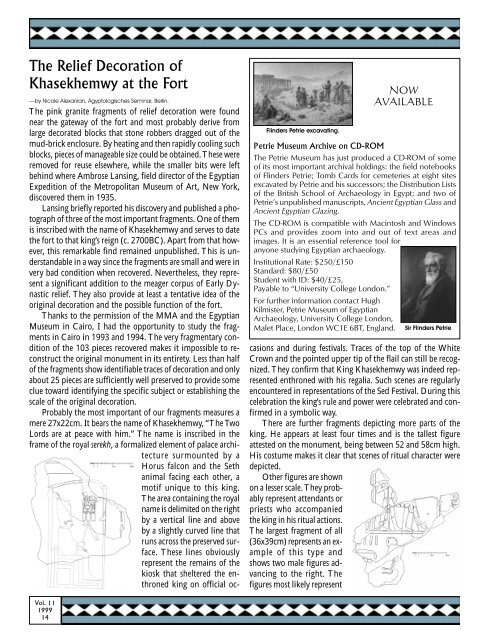Nekhen News 11 - Hierakonpolis Online
Nekhen News 11 - Hierakonpolis Online
Nekhen News 11 - Hierakonpolis Online
Create successful ePaper yourself
Turn your PDF publications into a flip-book with our unique Google optimized e-Paper software.
The Relief Decoration of<br />
Khasekhemwy at the Fort<br />
—by Nicole Alexanian, Ägyptologisches Seminar, Berlin.<br />
The pink granite fragments of relief decoration were found<br />
near the gateway of the fort and most probably derive from<br />
large decorated blocks that stone robbers dragged out of the<br />
mud-brick enclosure. By heating and then rapidly cooling such<br />
blocks, pieces of manageable size could be obtained. These were<br />
removed for reuse elsewhere, while the smaller bits were left<br />
behind where Ambrose Lansing, field director of the Egyptian<br />
Expedition of the Metropolitan Museum of Art, New York,<br />
discovered them in 1935.<br />
Lansing briefly reported his discovery and published a photograph<br />
of three of the most important fragments. One of them<br />
is inscribed with the name of Khasekhemwy and serves to date<br />
the fort to that king’s reign (c. 2700BC). Apart from that however,<br />
this remarkable find remained unpublished. This is understandable<br />
in a way since the fragments are small and were in<br />
very bad condition when recovered. Nevertheless, they represent<br />
a significant addition to the meager corpus of Early Dynastic<br />
relief. They also provide at least a tentative idea of the<br />
original decoration and the possible function of the fort.<br />
Thanks to the permission of the MMA and the Egyptian<br />
Museum in Cairo, I had the opportunity to study the fragments<br />
in Cairo in 1993 and 1994. The very fragmentary condition<br />
of the 103 pieces recovered makes it impossible to reconstruct<br />
the original monument in its entirety. Less than half<br />
of the fragments show identifiable traces of decoration and only<br />
about 25 pieces are sufficiently well preserved to provide some<br />
clue toward identifying the specific subject or establishing the<br />
scale of the original decoration.<br />
Probably the most important of our fragments measures a<br />
mere 27x22cm. It bears the name of Khasekhemwy, “The Two<br />
Lords are at peace with him.” The name is inscribed in the<br />
frame of the royal serekh, a formalized element of palace architecture<br />
surmounted by a<br />
Horus falcon and the Seth<br />
animal facing each other, a<br />
motif unique to this king.<br />
The area containing the royal<br />
name is delimited on the right<br />
by a vertical line and above<br />
by a slightly curved line that<br />
runs across the preserved surface.<br />
These lines obviously<br />
represent the remains of the<br />
kiosk that sheltered the enthroned<br />
king on official oc-<br />
Vol. <strong>11</strong><br />
1999<br />
14<br />
Flinders Petrie excavating.<br />
NOW<br />
AVAILABLE<br />
Petrie Museum Archive on CD-ROM<br />
The Petrie Museum has just produced a CD-ROM of some<br />
of its most important archival holdings: the field notebooks<br />
of Flinders Petrie; Tomb Cards for cemeteries at eight sites<br />
excavated by Petrie and his successors; the Distribution Lists<br />
of the British School of Archaeology in Egypt; and two of<br />
Petrie’s unpublished manuscripts, Ancient Egyptian Glass and<br />
Ancient Egyptian Glazing.<br />
The CD-ROM is compatible with Macintosh and Windows<br />
PCs and provides zoom into and out of text areas and<br />
images. It is an essential reference tool for<br />
anyone studying Egyptian archaeology.<br />
Institutional Rate: $250/£150<br />
Standard: $80/£50<br />
Student with ID: $40/£25,<br />
Payable to “University College London.”<br />
For further information contact Hugh<br />
Kilmister, Petrie Museum of Egyptian<br />
Archaeology, University College London,<br />
Malet Place, London WC1E 6BT, England. Sir Flinders Petrie<br />
casions and during festivals. Traces of the top of the White<br />
Crown and the pointed upper tip of the flail can still be recognized.<br />
They confirm that King Khasekhemwy was indeed represented<br />
enthroned with his regalia. Such scenes are regularly<br />
encountered in representations of the Sed Festival. During this<br />
celebration the king’s rule and power were celebrated and confirmed<br />
in a symbolic way.<br />
There are further fragments depicting more parts of the<br />
king. He appears at least four times and is the tallest figure<br />
attested on the monument, being between 52 and 58cm high.<br />
His costume makes it clear that scenes of ritual character were<br />
depicted.<br />
Other figures are shown<br />
on a lesser scale. They probably<br />
represent attendants or<br />
priests who accompanied<br />
the king in his ritual actions.<br />
The largest fragment of all<br />
(36x39cm) represents an example<br />
of this type and<br />
shows two male figures advancing<br />
to the right. The<br />
figures most likely represent


